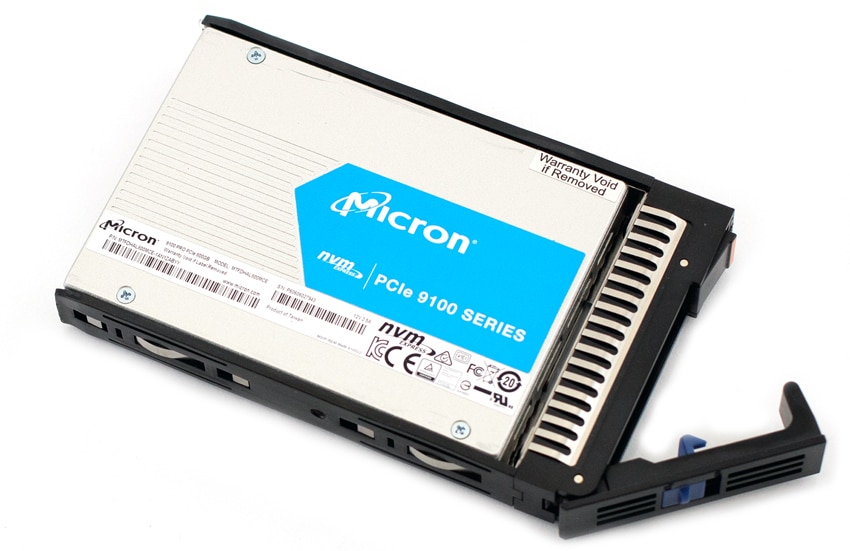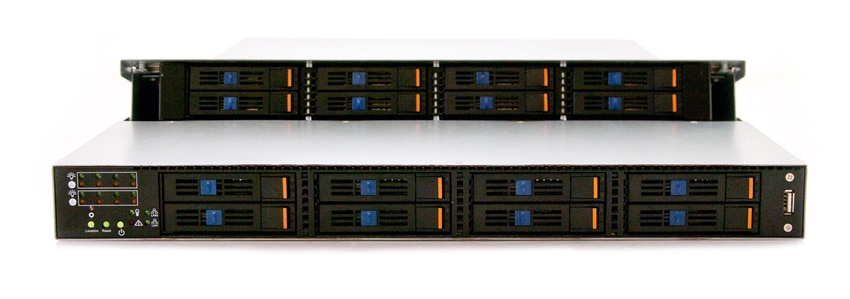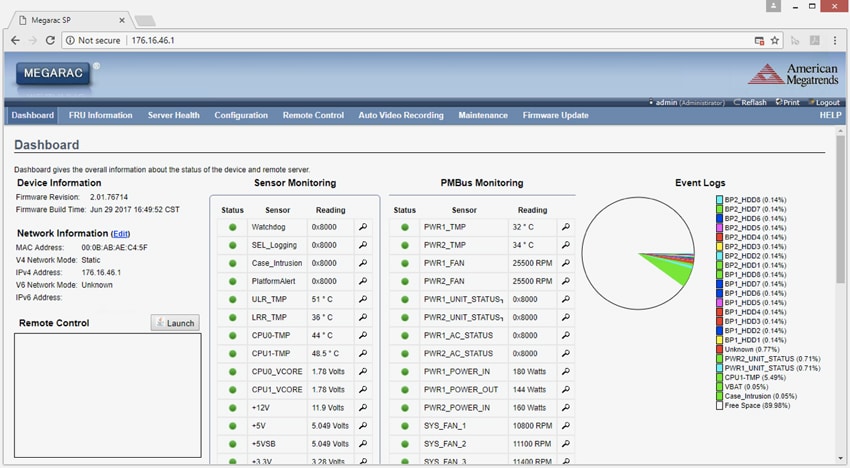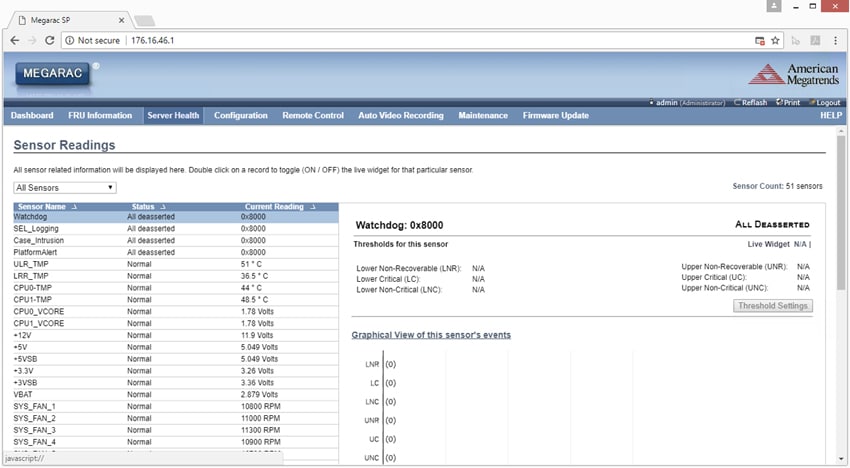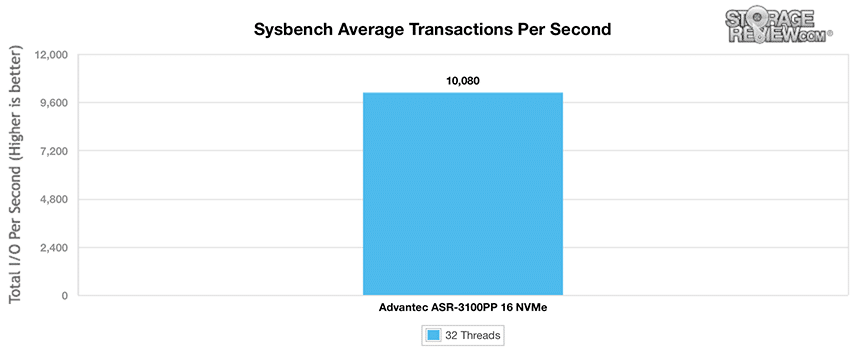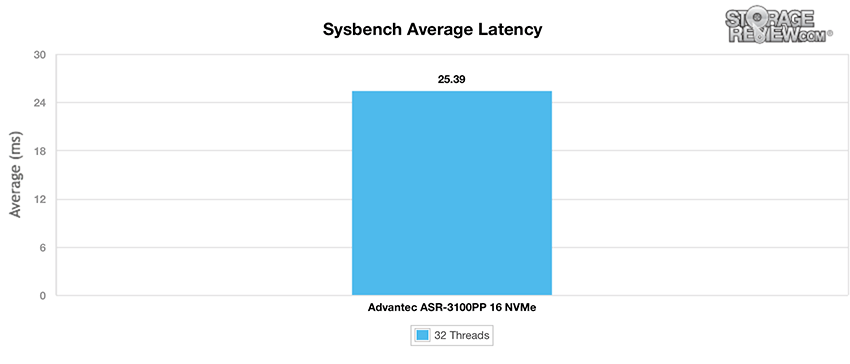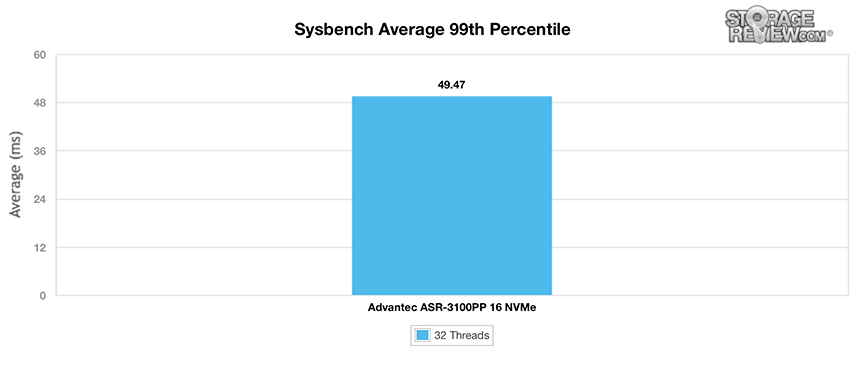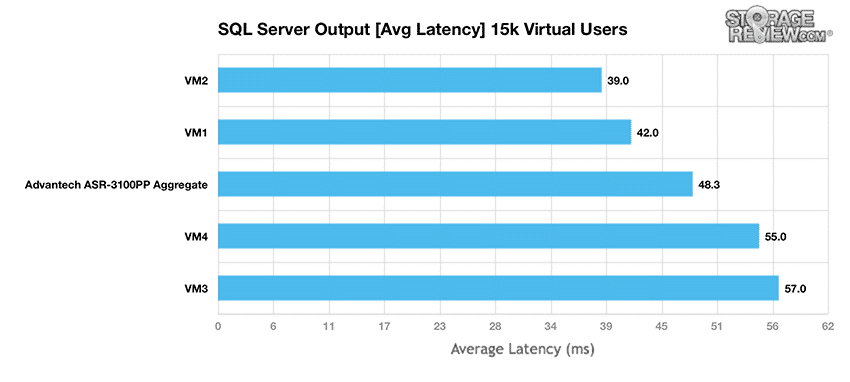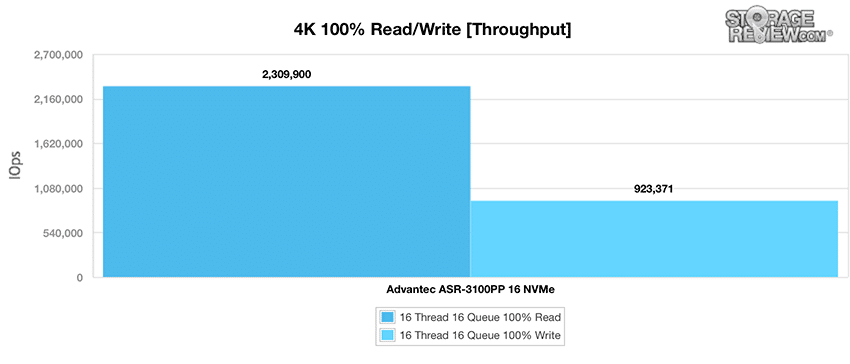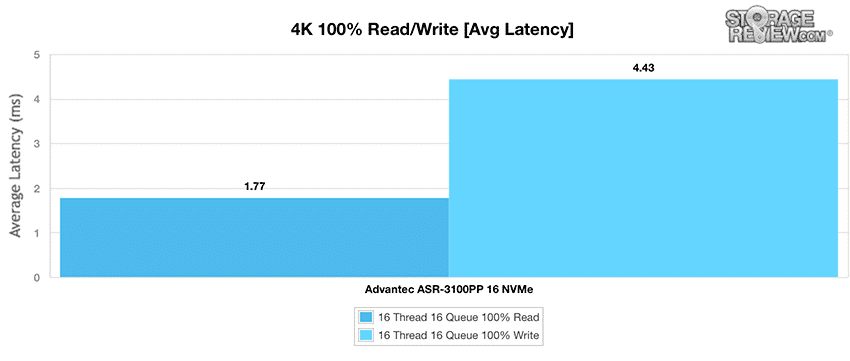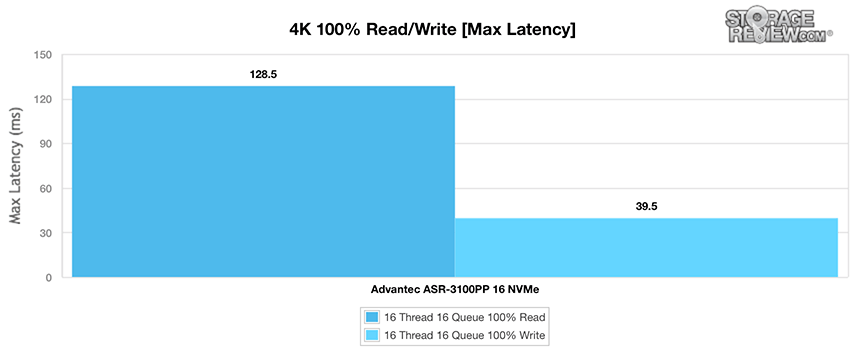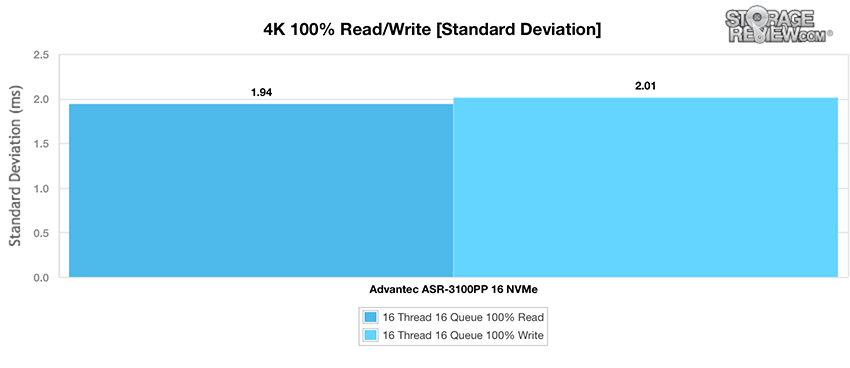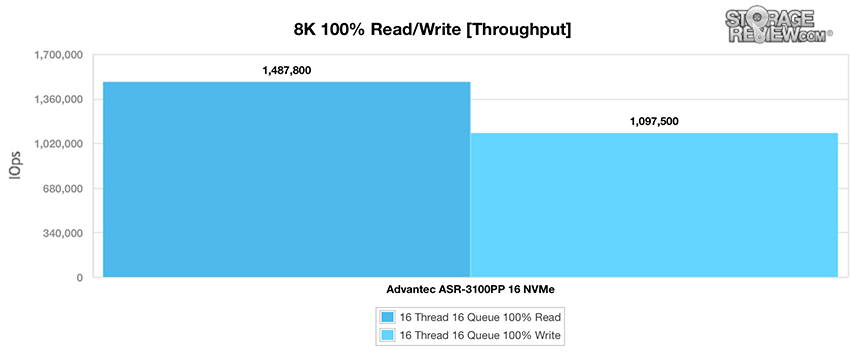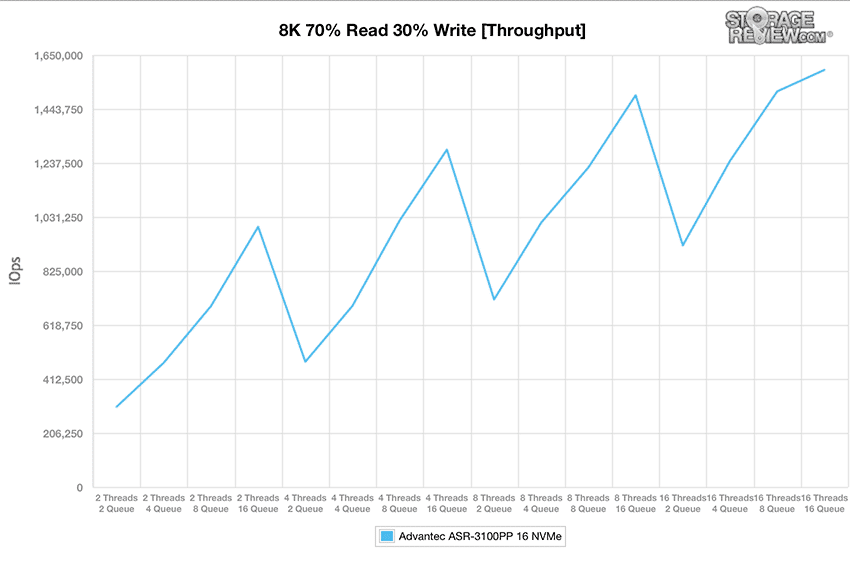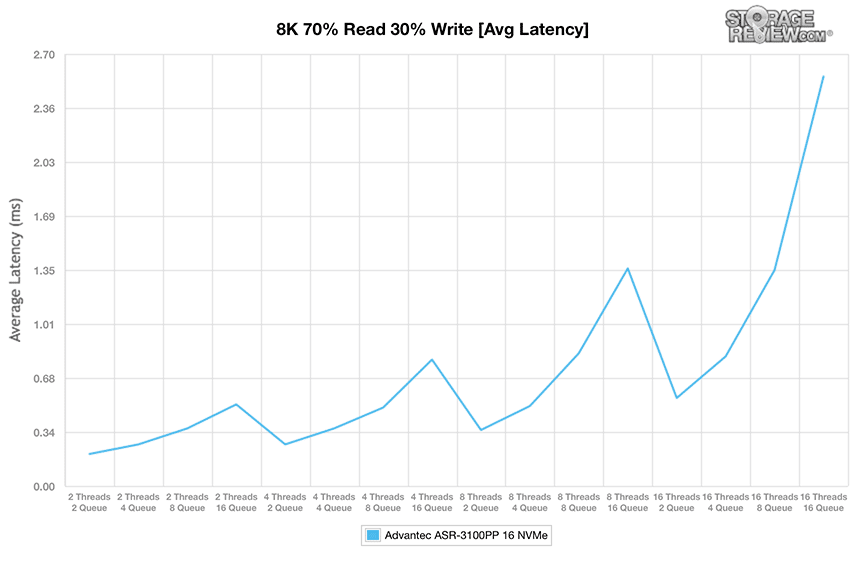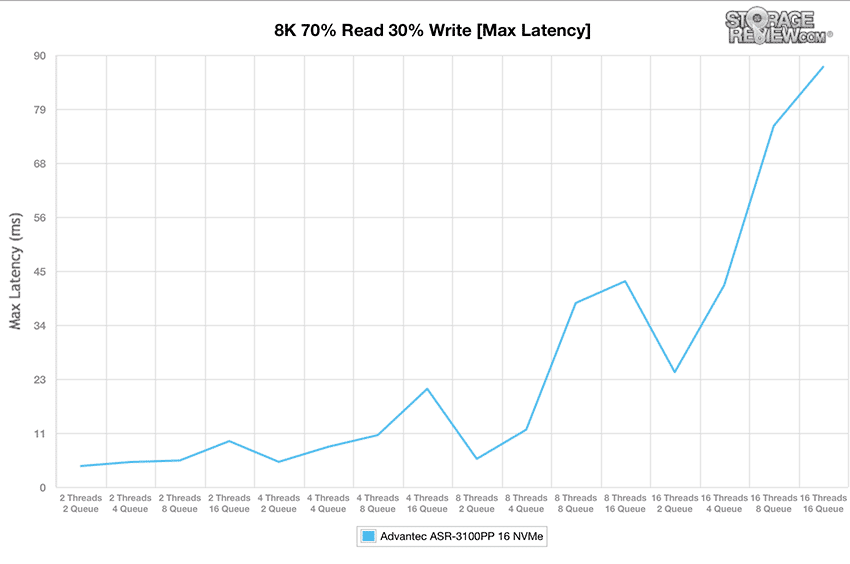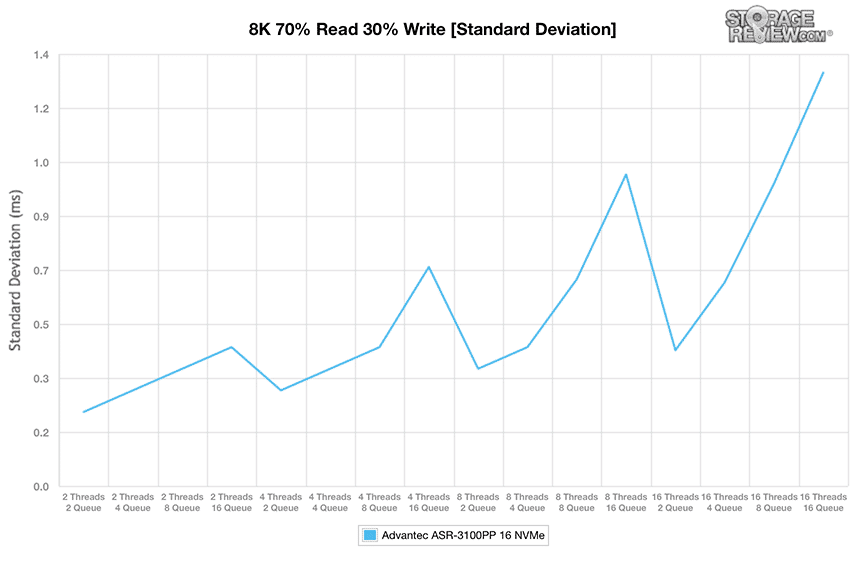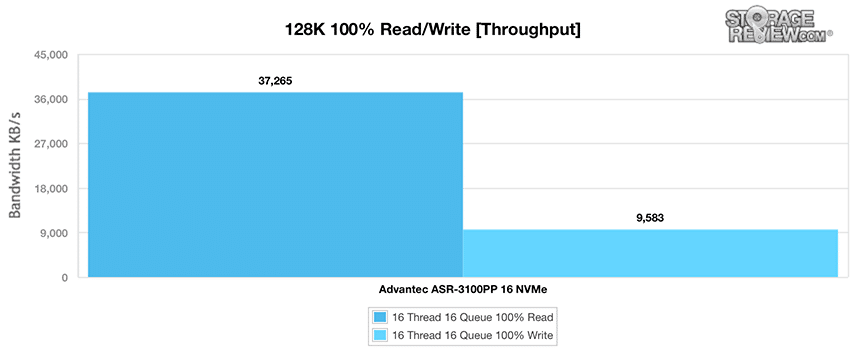
The Advantech ASR-3100PP is part of the larger ASR-3100 series which is comprised of storage-heavy 1U servers. Each server offers up 16 bays of 2.5″ storage, in a double-stack format, with 8 bays in the traditional front of the box and another 8 that pop up right behind those near the front of the chassis. The ASR-3100PP variant is unique in that it is NVMe throughout, which offers a tremendous performance profile in just a single rack unit. To ensure customers get to use all of their NVMe storage for important applications, Advantech includes two M.2 2242 SATA slots on the motherboard for OS installation, with optional RAID1 mirror. Additionally the system offers 16 DIMM slots for up to 512GB RAM, dual Intel Xeon E5-2600 v3/v4 CPU slots, two PCIe x8 expansion slots (one FHHL, one HHHL), redundant 1100W redundant power supplies and IPMI support.
Consolidating so many NVMe drives into a 1U chassis opens up a number of use cases for the ASR-3100PP. Running applications like transactional databases locally for maximum performance would be a common starting point. The system also plays well for bandwidth-heavy requirements like those found in rendering and editing in the media and entertainment space. For environments that run their own software, the ASR-3100PP could make a great cache or tier in a large environment. Of course, a myriad of software-defined vendors could make use of the platform as well, though most of them are a bit behind the curve in terms of being able to harness this much storage performance.
For this particular model, Micron supplied all of the NVMe SSDs (800GB 9100 SSD) and the RAM (in this case sixteen 32GB DIMMs for a total of 512GB). While CPUs and networking go a long way toward increasing the performance of any given server, the above contributions from Micron will really make a huge impact on improving the overall performance of the ASR-3100PP. The second row and drive bays also allows for SATA drives (with SAS optional) for those who want to add more capacity at a lower price.
Advantech ASR-3100PP Specifications
- Form Factor: 1U
- CPU: Intel Xeon E5-2600 v3/v4 series (LGA2011-R3 socket)
- Chipset: Intel C612
- Memory max: 512GB DDR4
- Drive bays: 16x 2.5” NVMe/SAS 12Gb/s/SATA 6Gbs
- I/O ports:
- 1x USB 2.0
- 4x USB 3.0
- 2x RJ-45 LAN
- 1x VGA
- 1x Communication
- PCIe slots: 2 x PCIe Gen3 x8 slots (Supports 1x HHHL card and 1x FHHL card)
- Power supply:
- 80 PLUS Platinum 1+1 redundant power supply
- 900W @ 100 ~ 120V
- 1100W @ 200 ~ 240V
- Input Range: AC 100 ~ 240 V
- Environment
- Operating temperature: 0 ~ 40° C (32 ~ 104° F)
- Operating humidity: 10 ~ 85% @ 40° C
- Vibration (5 ~ 500 Hz): 0.25 Grms
- Dimensions (W x H x D): 806 x 430 x 44 (mm)
Design and Build
The Advantech ASR-3100PP is a 1U server with a unique way of getting 16 NVMe drives in through the front. Along the front of the device are eight 2.5” bays. Also on the left-hand side is the power, location, and reset button, as well as drive and LAN indicator lights. The right-hand side of the device has a USB 2.0 port. Directly behind the first 8 bays is a second set of 8 bays. In order to get to them, users need to pull two tabs forward and then pull the second tray up at an angle. It’s not the easiest thing to get into, but there should be no concerns about this second tray opening accidentally.
Moving around to the rear of the device, from left to right, there are two removable PSUs, a serial port and a VGA port, four USB 3.0 ports, two RJ-45 LAN ports, and two PCIe slots (one is populated with our 10GbE NIC).
Management
Looking at the ASR-3100PP’s management, the server uses American Megatrends MEGARAC IPMI management software. From the main screen, users can easily see things such as device and networking information, sensor and PMBus monitoring, and the events log.
Clicking on server health, users can drill down into things such as sensor health for a more detailed look at what is going on in the server.
Sysbench Performance
Each Sysbench VM is configured with three vDisks, one for boot (~92GB), one with the pre-built database (~447GB), and the third for the database under test (270GB). From a system-resource perspective, we configured each VM with 16 vCPUs, 60GB of DRAM and leveraged the LSI Logic SAS SCSI controller.
Sysbench Testing Configuration (per VM)
- CentOS 6.3 64-bit
- Storage Footprint: 1TB, 800GB used
- Percona XtraDB 5.5.30-rel30.1
- Database Tables: 100
- Database Size: 10,000,000
- Database Threads: 32
- RAM Buffer: 24GB
- Test Length: 3 hours
- 2 hours preconditioning 32 threads
- 1 hour 32 threads
Our Sysbench test measures average TPS (Transactions Per Second), average latency, and the average 99th percentile latency at a peak load of 32 threads. First looking at the average TPS, the ASR-3100 hit a strong 10,080 TPS where one MySQL VM was sitting on each NVMe SSD. The main constraint of this test wasn’t the NVMe SSDs, but the CPUs themselves topping out.
Moving to the average latency of the Sysbench benchmark, the ASR-3100 maintained an average latency of 25.39ms during the impressive workload.
In terms of our worst-case MySQL latency scenario (99th percentile latency), the ASR-3100 went no higher than 49.47ms.
SQL Server Performance
StorageReview’s Microsoft SQL Server OLTP testing protocol employs the current draft of the Transaction Processing Performance Council’s Benchmark C (TPC-C), an online transaction processing benchmark that simulates the activities found in complex application environments. The TPC-C benchmark comes closer than synthetic performance benchmarks to gauging the performance strengths and bottlenecks of storage infrastructure in database environments.
Each SQL Server VM is configured with two vDisks: 100GB volume for boot and a 500GB volume for the database and log files. From a system resource perspective, we configured each VM with 16 vCPUs, 64GB of DRAM and leveraged the LSI Logic SAS SCSI controller. While our Sysbench workloads tested previously saturated the platform in both storage I/O and capacity, the SQL test looks for latency performance.
This test uses SQL Server 2014 running on Windows Server 2012 R2 guest VMs, being stressed by Dell’s Benchmark Factory for Databases. While our traditional usage of this benchmark has been to test large 3,000-scale databases on local or shared storage, in this iteration we focus on spreading out four 1,500-scale databases evenly across our servers.
SQL Server Testing Configuration (per VM)
- Windows Server 2012 R2
- Storage Footprint: 600GB allocated, 500GB used
- SQL Server 2014
- Database Size: 1,500 scale
- Virtual Client Load: 15,000
- RAM Buffer: 48GB
- Test Length: 3 hours
- 2.5 hours preconditioning
- 30 minutes sample period
During the SQL Server test, the ASR-3100 gave a strong performance of 12,520.8 TPS in aggregate. Individual VMs ranged from 3,124.8 TPS to 3,136 TPS. In this case, only 4 NVMe SSDs were leveraged, and being a latency-sensitive test, a different model drive would react differently.
In average latency for SQL Server, the ASR-3100 had an aggregate latency of 48.3ms with individual VMs ranging from 39ms to 57ms.
Enterprise Synthetic Workload Analysis
Our enterprise hard-drive benchmark process preconditions each drive into steady-state with the same workload the device will be tested with under a heavy load of 16 threads, with an outstanding queue of 16 per thread. It is then tested in set intervals in multiple thread/queue depth profiles to show performance under light and heavy usage. Since hard drives reach their rated performance level very quickly, we only graph out the main sections of each test.
Preconditioning and Primary Steady-State Tests:
- Throughput (Read+Write IOPS Aggregate)
- Average Latency (Read+Write Latency Averaged Together)
- Max Latency (Peak Read or Write Latency)
- Latency Standard Deviation (Read+Write Standard Deviation Averaged Together)
Our Enterprise Synthetic Workload Analysis includes four profiles based on real-world tasks. These profiles have been developed to make it easier to compare to our past benchmarks, as well as widely-published values such as max 4K read and write speed and 8K 70/30, which is commonly used for enterprise drives.
- 4K
- 100% Read or 100% Write
- 100% 4K
- 8K 70/30
- 70% Read, 30% Write
- 100% 8K
- 128K (Sequential)
- 100% Read or 100% Write
- 100% 128K
In the first of our enterprise workloads, we measured a long sample of random 4K performance with 100% write and 100% read activity. Here the ASR-3100 hit an impressive 2,309,900 IOPS read and 923,371 IOPS write.
With average latency, the ASR-3100 hit another round of impressive numbers with a read latency of 1.77ms and a write latency of 4.43ms.
With max latency, the numbers crept up quite a bit to 128.5ms read and 39.5ms write.
And the ASR-3100 finished out the 4K benchmarks with yet another impressive set of numbers in standard deviation with 1.94ms read and 2.01ms write.
In our next benchmark, we doubled the transfer size to 8K. Once again, the ASR-3100 brought impressive numbers to the table with 1,487,800 IOPS read and 1,097,500 IOPS write.
In our next four charts, we will be showing results based on a protocol consisting of 70% read operations and 30% write operations with an 8K transfer size. As such, the workload is then varied from 2 threads and a queue depth of 2 up to 16 threads and 16 queue. Here the ASR-3100 peaked at nearly 1.6 million IOPS.
Again, average latency was impressive. This time throughout the benchmark, average latency started as low as 0.2ms and peaked at only 2.56ms.
Max latency started off strong before rapidly increasing and peaking at 87.55ms.
And once again, the ASR-3100 finished strong with standard deviation latency ranging from 0.24ms to only 1.34ms.
The final synthetic benchmark utilizes much larger 128K transfer sizes with 100% read and 100% write operations. Here the Advantech ASR-3100 really had some whoppers. For read, the server hit 37.265GB/s and for write, it hit 9.583GB/s.
Conclusion
Advantech has figured out how to cram sixteen 2.5” NVMe SSDs into a 1U form factor and produce an extremely high-performance server with it. A unique feature to this server is the fact that there are 8 front-loading bays for hot-swap NVMe SSDs, with a second set of 8 bays right behind the first that can be accessed by flipping up the section at roughly a 45-degree angle. Aside from this, the small footprint server has dual Intel Xeon E5-2600 v3/v4 CPU, up to 512GB of RAM, IPMI support, and two PCIe slots for further expansion. For our particular build, Micron supplied sixteen 800GB 9100 NVMe drives and 512GB of DDR4 ram (16 x 32GB DIMMs).
Looking at performance, the ASR-3100PP had strong SysBench and SQL Server numbers. For SysBench, the server had a TPS score of 10,080, with 25.38ms average latency and 49.47ms in worst-case scenario latency. Sysbench is very CPU intensive, so users could reach those similar performance numbers with fewer drives, albeit higher capacity models. SQL Server also had strong numbers with aggregate scores of 12,520.8 TPS and 48.3ms average latency. Our SQL Server test (while not CPU limited) may yield different or better results using different SSD models. From a storage perspective, the ASR-3100PP is drive agnostic, so the sky really is the limit on how a customer ends up configuring it.
Switching to synthetic, the ASR-3100PP’s incredible potential really shone through. In our 4K benchmarks, the server hit a throughput over 2.3 million IOPS read and 923K IOPS write, with average latency measuring 1.77ms read and 4.43ms write with an effective queue depth of 256 per drive. In 100% Read/Write 8K throughput, the server hit nearly 1.5 million IOPS read and over 1 million IOPS write. With 8K 70% Read/ 30% Write, the server had another impressive throughput number peaking at over 1.5 million IOPS. And in our large-block 128K benchmark, the server had incredible 37.3GB/s read and 9.6GB/s write. For use cases that can take advantage of this server, the results are simply incredible.
Pros
- 16 NVMe drives in a 1U form factor
- Low starting price
- Record-setting synthetic performance
Cons
- PCIe expansion limited to just 16 lanes (or ~12-13GB/s out)
The Bottom Line
The Advantech ASR-3100PP is an ideal server for enterprise buyers who can properly take advantage of the maximum performance this server delivers, benefitting from the dense footprint at the same time.
Advantech ASR-3100PP Product Page


